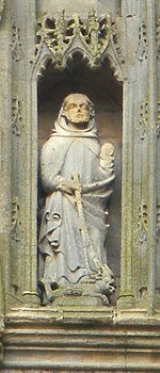
Saint Guthlac
Encyclopedia
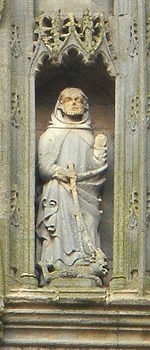
Christian
A Christian is a person who adheres to Christianity, an Abrahamic, monotheistic religion based on the life and teachings of Jesus of Nazareth as recorded in the Canonical gospels and the letters of the New Testament...
saint
Saint
A saint is a holy person. In various religions, saints are people who are believed to have exceptional holiness.In Christian usage, "saint" refers to any believer who is "in Christ", and in whom Christ dwells, whether in heaven or in earth...
from Lincolnshire
Lincolnshire
Lincolnshire is a county in the east of England. It borders Norfolk to the south east, Cambridgeshire to the south, Rutland to the south west, Leicestershire and Nottinghamshire to the west, South Yorkshire to the north west, and the East Riding of Yorkshire to the north. It also borders...
in England
England
England is a country that is part of the United Kingdom. It shares land borders with Scotland to the north and Wales to the west; the Irish Sea is to the north west, the Celtic Sea to the south west, with the North Sea to the east and the English Channel to the south separating it from continental...
. He is particularly venerated in the Fens
The Fens
The Fens, also known as the , are a naturally marshy region in eastern England. Most of the fens were drained several centuries ago, resulting in a flat, damp, low-lying agricultural region....
of eastern England.
Life
Guthlac was the son of Penwalh or Penwald, a noble of the EnglishEngland
England is a country that is part of the United Kingdom. It shares land borders with Scotland to the north and Wales to the west; the Irish Sea is to the north west, the Celtic Sea to the south west, with the North Sea to the east and the English Channel to the south separating it from continental...
kingdom
Monarchy
A monarchy is a form of government in which the office of head of state is usually held until death or abdication and is often hereditary and includes a royal house. In some cases, the monarch is elected...
of Mercia
Mercia
Mercia was one of the kingdoms of the Anglo-Saxon Heptarchy. It was centred on the valley of the River Trent and its tributaries in the region now known as the English Midlands...
, and his wife Tette. His sister is also venerated as Saint Pega
Pega
Pega , was an anchoress of Mercia, and the sister of Saint Guthlac. She was born in Mercia. She lived as an anchoress at Peakirk in the modern county of Cambridgeshire, not far from Guthlac's hermitage at Crowland. When he realized that his end was near in 714, he invited her to his funeral...
. As a young man, he fought in the army of Æthelred of Mercia and subsequently became a monk
Monk
A monk is a person who practices religious asceticism, living either alone or with any number of monks, while always maintaining some degree of physical separation from those not sharing the same purpose...
at Repton Monastery
Repton
Repton is a village and civil parish on the edge of the River Trent floodplain in South Derbyshire, about north of Swadlincote. Repton is close to the county boundary with neighbouring Staffordshire and about northeast of Burton upon Trent.-History:...
in Derbyshire
Derbyshire
Derbyshire is a county in the East Midlands of England. A substantial portion of the Peak District National Park lies within Derbyshire. The northern part of Derbyshire overlaps with the Pennines, a famous chain of hills and mountains. The county contains within its boundary of approx...
at age twenty-four. Two years later he sought to live the life of a hermit
Hermit
A hermit is a person who lives, to some degree, in seclusion from society.In Christianity, the term was originally applied to a Christian who lives the eremitic life out of a religious conviction, namely the Desert Theology of the Old Testament .In the...
, and moved out to the island of Croyland, now called Crowland
Crowland
Crowland or Croyland is a small town in south Lincolnshire, England, positioned between Peterborough and Spalding, with two sites of historical interest.-Geography:...
on St Bartholomew's Day, AD 699. His early biographer Felix asserts that Guthlac could understand the strimulentes loquelas of the British-speaking demons who haunted him there, only because Guthlac had spent some time in exile among British-speaking people.
Guthlac built a small oratory
Oratory (worship)
An oratory is a Christian room for prayer, from the Latin orare, to pray.-Catholic church:In the Roman Catholic Church, an oratory is a structure other than a parish church, set aside by ecclesiastical authority for prayer and the celebration of Mass...
and cells
Monastery
Monastery denotes the building, or complex of buildings, that houses a room reserved for prayer as well as the domestic quarters and workplace of monastics, whether monks or nuns, and whether living in community or alone .Monasteries may vary greatly in size – a small dwelling accommodating only...
to live in in the side of a plundered barrow
Tumulus
A tumulus is a mound of earth and stones raised over a grave or graves. Tumuli are also known as barrows, burial mounds, Hügelgrab or kurgans, and can be found throughout much of the world. A tumulus composed largely or entirely of stones is usually referred to as a cairn...
on the island, and he lived there the rest of his life until his death on April 11 in AD 714. Felix, writing within living memory of Guthlac, says that Guthlac dressed in animal skins, and the only nourishment he took was a scrap of barley bread and a small cup of muddy water after sunset. Ague
Ague
Ague may refer to:* Fever* MalariaSee also:* Kan Ague, a residential area of Patikul, Sulu, Philippines...
and marsh fever assailed him.
His pious and holy ascetic life became the talk of the land, and many people visited Guthlac during his life to seek spiritual guidance from him. He gave sanctuary to Æthelbald, future king of Mercia
Mercia
Mercia was one of the kingdoms of the Anglo-Saxon Heptarchy. It was centred on the valley of the River Trent and its tributaries in the region now known as the English Midlands...
, who was fleeing from his cousin Ceolred
Ceolred of Mercia
-Mercia at the end of the 7th century:By the end of the 7th century, England was almost entirely divided into kingdoms ruled by the Anglo-Saxons, who had come to Britain two hundred years earlier. The kingdom of Mercia occupied what is now the English Midlands, bordered by Northumbria to the...
. Guthlac predicted that Æthelbald would become king, and Æthelbald promised to build him an abbey
Abbey
An abbey is a Catholic monastery or convent, under the authority of an Abbot or an Abbess, who serves as the spiritual father or mother of the community.The term can also refer to an establishment which has long ceased to function as an abbey,...
if his prophecy became true. Æthelbald did become king and, even though Guthlac had died two years previously, kept his word and started construction of Crowland Abbey on St Bartholomew's Day 716 AD. Guthlac's feast day is celebrated on April 11.
The 8th century Latin Vita sancti Guthlaci is written by Felix. A short Old English sermon (Vercelli
Vercelli
Vercelli is a city and comune of about 47,000 inhabitants in the Province of Vercelli, Piedmont, northern Italy. One of the oldest urban sites in northern Italy, it was founded, according to most historians, around the year 600 BC.The city is situated on the river Sesia in the plain of the river...
XXIII) and a longer prose translation into Old English are both based on Felix's Vita. There are also two poems in Old English known as Guthlac A
Guthlac poems A and B
Guthlac A and Guthlac B are poems about a title hero, unique in that they are the only known poems in Old English written about a Mercian saint, Saint Guthlac, whose reputation as a plain-living hermit is well-known. Both are preserved in the Exeter Book, consecutively, because for a long time,...
and Guthlac B
Guthlac poems A and B
Guthlac A and Guthlac B are poems about a title hero, unique in that they are the only known poems in Old English written about a Mercian saint, Saint Guthlac, whose reputation as a plain-living hermit is well-known. Both are preserved in the Exeter Book, consecutively, because for a long time,...
. The relationship of Guthlac A to Felix's Vita is debated, but Guthlac B is based on Felix's account of the saint's death. The story of Saint Guthlac is told pictorially in the Guthlac Roll, a set of detailed illustrations of the 12th century; it is kept in the British Library
British Library
The British Library is the national library of the United Kingdom, and is the world's largest library in terms of total number of items. The library is a major research library, holding over 150 million items from every country in the world, in virtually all known languages and in many formats,...
. Copies of it can be seen on display at Crowland Abbey.
The St Guthlac Fellowship
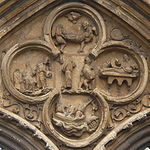
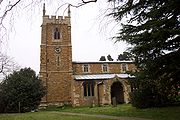
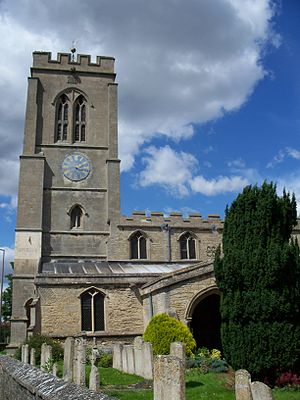
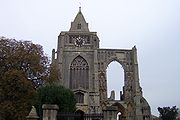
- Crowland Abbey, LincolnshireLincolnshireLincolnshire is a county in the east of England. It borders Norfolk to the south east, Cambridgeshire to the south, Rutland to the south west, Leicestershire and Nottinghamshire to the west, South Yorkshire to the north west, and the East Riding of Yorkshire to the north. It also borders...
- AstwickAstwickAstwick is a village and civil parish in Bedfordshire. It is just to the north of Stotfold.The village is the site of Astwick Hall. It is on the River Ivel, and is just west of the A1. Apart from Stotfold, nearby places include Biggleswade and Hinxworth....
church, BedfordshireBedfordshireBedfordshire is a ceremonial county of historic origin in England that forms part of the East of England region.It borders Cambridgeshire to the north-east, Northamptonshire to the north, Buckinghamshire to the west and Hertfordshire to the south-east.... - All Saints Parish Church, Branston, LincolnshireBranston, LincolnshireBranston is a large village in the North Kesteven district of Lincolnshire, England, approximately south-east of Lincoln.In the 2001 Census the population was recorded as 4019.-Geography:...
- Our Lady and St Guthlac Roman Catholic church, Deeping St JamesDeeping St JamesDeeping St James is a large village in Lincolnshire, England.-Geography:Deeping St James lies east of Market Deeping on the River Welland, in the middle of rich sedimentary agricultural land on the B1166 and B1162 roads. With a population of 6,923 in 2837 households, it is the largest of The...
, Lincolnshire - Little Cowarne Church, HerefordshireHerefordshireHerefordshire is a historic and ceremonial county in the West Midlands region of England. For Eurostat purposes it is a NUTS 3 region and is one of three counties that comprise the "Herefordshire, Worcestershire and Gloucestershire" NUTS 2 region. It also forms a unitary district known as the...
- St Guthlac's Church, Market Deeping, LincolnshireSaint Guthlac's Church, Market DeepingSaint Guthlac's Church, Market Deeping is a parish church in the Church of England in Market Deeping, Lincolnshire.-Background:The largely 15th century church of St Guthlac is the only church in Market Deeping, Lincolnshire, England and part of the Church of England in the Anglo-Catholic Tradition...
- FishtoftFishtoftFishtoft is one of eighteen parishes which, together with Boston, form the Borough of Boston in the county of Lincolnshire, England. Local government has been arranged in this way since the reorganization of 1 April 1974, which resulted from the Local Government Act 1972...
Church, Lincolnshire - St Guthlac, Knighton, LeicestershireKnighton, LeicestershireKnighton is an area of Leicester, situated roughly between Clarendon Park to the north, Stoneygate to the east, Oadby and Wigston to the south and the Saffron Lane estate to the west...
- Little PontonLittle PontonLittle Ponton is a small village just south of Grantham in South Kesteven. Lincolnshire.-Geography:It is part of the civil parish of Little Ponton and Stroxton. It is situated just off the B1174 ....
Church, Lincolnshire - PassenhamPassenhamPassenham is a small village in the civil parish of Old Stratford in South Northamptonshire, England. It is just north of the River Great Ouse, which forms the boundary with Buckinghamshire, and close to Stony Stratford in Milton Keynes.-Governance:The village parish council is joined with the...
Church, NorthamptonshireNorthamptonshireNorthamptonshire is a landlocked county in the English East Midlands, with a population of 629,676 as at the 2001 census. It has boundaries with the ceremonial counties of Warwickshire to the west, Leicestershire and Rutland to the north, Cambridgeshire to the east, Bedfordshire to the south-east,... - St Guthlac's Church, StathernStathernStathern is a village and civil parish in the Melton district of Leicestershire, England. It is in the Vale of Belvoir about north of Melton Mowbray. In the 2001 census the parish had 288 dwellings, and a population of 672.-External links:...
, NottinghamshireNottinghamshireNottinghamshire is a county in the East Midlands of England, bordering South Yorkshire to the north-west, Lincolnshire to the east, Leicestershire to the south, and Derbyshire to the west...
Further reading
Primary sources- Felix, Vita Sancti Guthlaci, early 8th century Latin prose Life of St Guthlac:
- Colgrave, Bertram (ed. and tr.). Felix's Life of Saint Guthlac. Cambridge: Cambridge University Press, 1956.
- Old English prose translation/adaptation (late 9tth or early 10th century) of the Life of St Guthlac by Felix:
- Gonser, P. (ed.). Das angelsächsische Prosa-Leben des heiligen Guthlac. Anglistische Forschungen 27. Heidelberg, 1909.
- Goodwin, Charles Wycliffe (ed. and tr.). The Anglo-Saxon Version of the Life of St. Guthlac, Hermit of Crowland. London, 1848.
- Two chapters from the Old English prose adaptation as incorporated into Vercelli HomilyVercelli HomiliesThe Vercelli homilies are a collection of twenty-three prose entries within the Vercelli book and exist as an important example of Old English prose structure, owing to the predominance of poetry within the pool of extant Old English literature. In keeping with the origins of the Vercelli...
23.- Scragg, D.G. (ed.). The Vercelli Homilies and Related Texts. EETS 300. Oxford: University Press, 1992.
- Guthlac A and Guthlac B (Old English poems):
- Roberts, Jane (ed.). The Guthlac Poems of the Exeter Book. Oxford: Clarendon Press, 1979.
- Krapp, G. and E.V.K. Dobbie (eds.). The Exeter Book. Anglo-Saxon Poetic Records 3. 1936. 49-88
- Bradley, S.A.J. (tr.). Anglo-Saxon Poetry. London: Everyman, 1982.
- Harley Roll or Guthlac Roll (BL, Harleian Roll Y.6)
- Warner, G.F. (ed.). The Guthlac Roll. Roxburghe Club, 1928. 25 plates in facsimile.
Secondary sources
- Olsen, Alexandra. Guthlac of Croyland: a Study of Heroic Hagiography. Washington, 1981.
- Powell, Stephen D. "The Journey Forth: Elegiac Consolation in Guthlac B." English Studies 79 (1998): 489-500.
- Roberts, Jane. "The Old English Prose Translation of Felix’s Vita Sancti Guthlaci." Studies in Earlier Old English Prose: Sixteen Original Contributions, ed. Paul E. Szarmach. Albany, 1986. 363-79.
- Roberts, Jane. "An inventory of early Guthlac materials." Mediaeval Studies 32 (1970): 193–233.
- Sharma, Manish. "A Reconsideration of Guthlac A: The Extremes of Saintliness." Journal of English and Germanic Philology 101 (2002): 185-200.
- Shook, Laurence K. "The Burial Mound in 'Guthlac A'." Modern PhilologyModern PhilologyModern Philology is a literary journal that was established in 1903. It publishes scholarly articles on literature, literary scholarship, history, and criticism in all modern world languages and book reviews of recent books as well as review articles and research on archival documents. It is...
58, 1 (Aug., 1960): 1-10. - Soon Ai, Low. "Mental Culturation in Guthlac B." NeophilologusNeophilologusNeophilologus, in full Neophilologus: an international journal of modern and mediaeval language and literature, is a peer-reviewed journal devoted to the study of modern and mediaeval languages and literature, including general linguistics, literary theory and comparative literature...
81 (1997): 625-36. - Roberts, Jane. "Guthlac of Crowland, a Saint for Middle England." Fursey Occasional Paper 3. Norwich: Fursey Pilgrims, 2009. 1-36. http://www.furseypilgrims.co.uk/publications.htm

